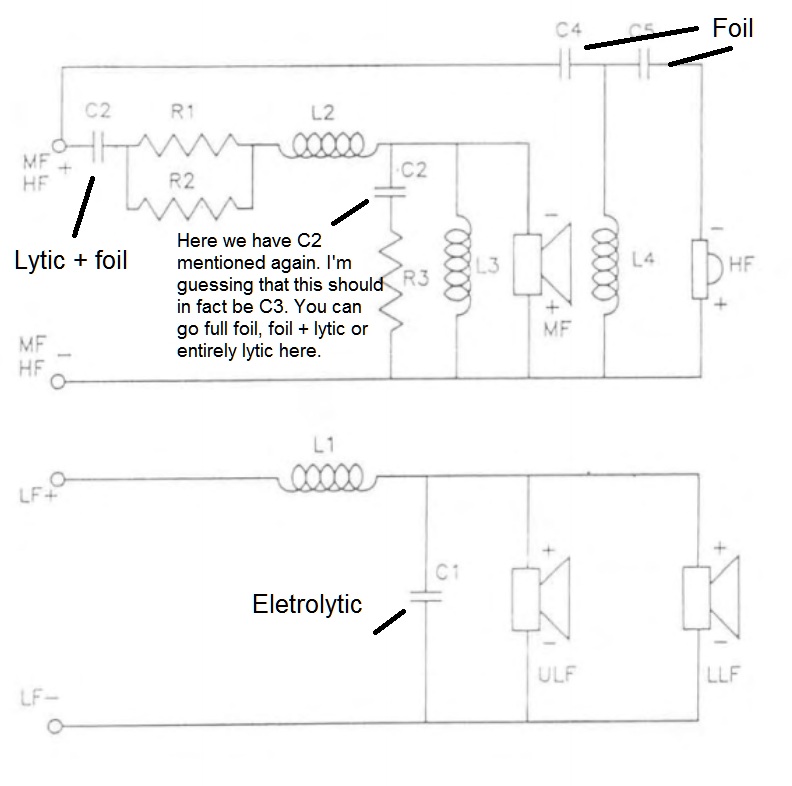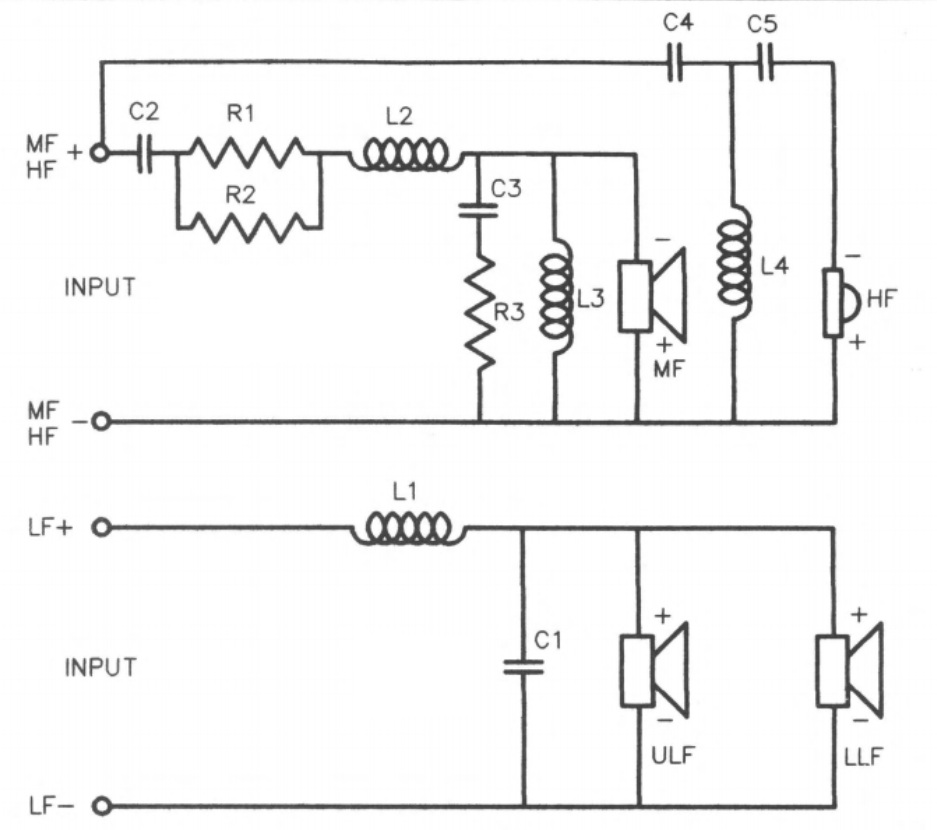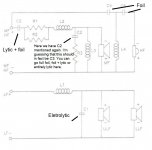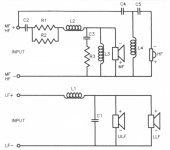I am upgrading my DM 640's and because they are "old" some are saying that they are dated. What would you say is the speaker systems weakest link? Bass driver, Mid, tweeter? I am going to upgrade the XO parts. I have my idea of where to make some mods and I wanted to see if your opinions were similar to mine. Thanks
Driver technology hasn't exactly changed in the past few years, but it entirely depends where and what price point these were originally put at and what kind of performance B&W were wanting them to have.
The drivers are probably decent but nothing amazing and the crossover is probably a design of minimal component count to cut costs, but probably not cost cutting to the point of degrading the performance to an unacceptable level. Then there's the designers own personal philosophies, these sometimes clash with what others would consider optimal and might push the design towards sounding something like you would not prefer. Of course it could work the other way around too.
According to the B&W service manual all of the capacitors used in the design are of the electrolytic variety. These are perfectly acceptable but do not stand the test of time particularly well. The DM640s design is 20 years old. I would recommend you change the electrolytics for either new electrolytics or go for film caps.
The service manuals can be found here.
Service Manuals
As a recommendation I'd keep C1 and the C2 that is paired with R3 as electrolytics, but replace C4, C5 and the C2 that goes before R1 with decent film caps.
If the price of C2, as an 85uF film cap, is a bit much (and I agree it is expensive) I'd buy a 70-80uF electrolytic cap and parallel it with a film cap to make up the remainder.
Solens basic series of film cap are fine.
Solen Capacitors: Madisound Speaker Store
As are Bennics lytic caps.
Bennic Capacitors: Madisound Speaker Store
You can parallel up any combination of capacitors to arrive at the required capacitance.
The drivers are probably decent but nothing amazing and the crossover is probably a design of minimal component count to cut costs, but probably not cost cutting to the point of degrading the performance to an unacceptable level. Then there's the designers own personal philosophies, these sometimes clash with what others would consider optimal and might push the design towards sounding something like you would not prefer. Of course it could work the other way around too.
According to the B&W service manual all of the capacitors used in the design are of the electrolytic variety. These are perfectly acceptable but do not stand the test of time particularly well. The DM640s design is 20 years old. I would recommend you change the electrolytics for either new electrolytics or go for film caps.
The service manuals can be found here.
Service Manuals
As a recommendation I'd keep C1 and the C2 that is paired with R3 as electrolytics, but replace C4, C5 and the C2 that goes before R1 with decent film caps.
If the price of C2, as an 85uF film cap, is a bit much (and I agree it is expensive) I'd buy a 70-80uF electrolytic cap and parallel it with a film cap to make up the remainder.
Solens basic series of film cap are fine.
Solen Capacitors: Madisound Speaker Store
As are Bennics lytic caps.
Bennic Capacitors: Madisound Speaker Store
You can parallel up any combination of capacitors to arrive at the required capacitance.
What would you say is the speaker systems weakest link?
Ferrite-cored inductors. Resistive pad used to bring down the sensitivity of the mid. Non-polar electrolytics.
Go active.
Right on. I am doing the XO ordering parts today. Thats funny how you picked up the mid being a little lod abraxalito. I was thinking it but was not planning to do anything. I'll now have to consider that. I think the high end tweeter sounds good. I'll follow up with results. Just a thought, as far as drivers I would keep the mid and tweeter but the 8 in woofers are probably the weakerst link there. They are a bit slow and do not have a ton of detail? Are there any good 8in drivers I could try? Seas?
Hmm C3 doesn't exist for me at all in the service manual for the DM640. The manual for the DM640i however does list C3.
I'll do this the easy way.
DM640.

DM640i.

The 640i lists C3.
There's nothing inherently bad about a good quality electrolytic although most will claim that foil sound better. Foil certainly have the advantage of stability vs time, but can end up costing a lot for large values. C5 in both designs is quite large in value and would represent a decent cost. You could go lytic here for the majority of the capacitance and parallel in a foil for the remainder.
As abraxalito states, there is nothing wrong with going active, but to do it properly will require certain expertise and most likely certain hardware upgrade too.
The bass qualities you speak of could be due to a lot of things and are unlikely to be caused by the bass drivers them selves. The subjective description of slow bass could be caused by room interactions with the loudspeakers or could stem from poor room integration because of the alignment the boxes are tuned to. The loudspeakers are ported, I take it you've tried stuffing the ports with a sock or moving the loudspeakers around a bit?
I'll do this the easy way.
DM640.
DM640i.
The 640i lists C3.
There's nothing inherently bad about a good quality electrolytic although most will claim that foil sound better. Foil certainly have the advantage of stability vs time, but can end up costing a lot for large values. C5 in both designs is quite large in value and would represent a decent cost. You could go lytic here for the majority of the capacitance and parallel in a foil for the remainder.
As abraxalito states, there is nothing wrong with going active, but to do it properly will require certain expertise and most likely certain hardware upgrade too.
The bass qualities you speak of could be due to a lot of things and are unlikely to be caused by the bass drivers them selves. The subjective description of slow bass could be caused by room interactions with the loudspeakers or could stem from poor room integration because of the alignment the boxes are tuned to. The loudspeakers are ported, I take it you've tried stuffing the ports with a sock or moving the loudspeakers around a bit?
Attachments
the 8 in woofers are probably the weakerst link there. They are a bit slow and do not have a ton of detail?
Don't blame those drivers so fast. Certainly not before you've chucked that 5mH ferrite-cored fount of distortion for something a tad more transparent
Don't blame those drivers so fast. Certainly not before you've chucked that 5mH ferrite-cored fount of distortion for something a tad more transparent
I think your probably over emphasising the effect that the inductor could be having on the sound. There is nothing wrong with using cored inductors providing they are of decent design and aren't over driven.
I will not tweak the B&W DM640. According to your feeling, you could have a problem with your electronic, amplifier, source ? Your amplifier can't supply correctly the 2x8inch ! A 8 inch is fast in the bass !
Try a better amplifier first and after if necessary a better CD player ?
Note for me a good amplifier looks like this :
Sugden A21ai Series 2 integrated amplifier | Stereophile.com
Accuphase Laboratory, Inc.?E-250
etc.
You can do it yourself or test...
Or
Change the speaker, go to a 8 ohms, one with a 10" ?
Make a proven design :
Jenzen CA
You can wait for a "better" version with high end drivers.
There are other design on his website ...
Try a better amplifier first and after if necessary a better CD player ?
Note for me a good amplifier looks like this :
Sugden A21ai Series 2 integrated amplifier | Stereophile.com
Accuphase Laboratory, Inc.?E-250
etc.
You can do it yourself or test...
Or
Change the speaker, go to a 8 ohms, one with a 10" ?
Make a proven design :
Jenzen CA
You can wait for a "better" version with high end drivers.
There are other design on his website ...
Right on. I am doing the XO ordering parts today. Thats funny how you picked up the mid being a little lod abraxalito. I was thinking it but was not planning to do anything. I'll now have to consider that. I think the high end tweeter sounds good. I'll follow up with results. Just a thought, as far as drivers I would keep the mid and tweeter but the 8 in woofers are probably the weakerst link there. They are a bit slow and do not have a ton of detail? Are there any good 8in drivers I could try? Seas?
I think your probably over emphasising the effect that the inductor could be having on the sound. There is nothing wrong with using cored inductors providing they are of decent design and aren't over driven.
Well I didn't say anything about whether its 'wrong' to use cored inductors. As you pointed out those designs are over 20 years old, they even pre-date my time at the company. They're just not very transparent, having easily measurable distortion (so I'm led to believe, not having passive speakers with ferrite cored inductors around to test myself). More recent B&W designs tend to use air-cored inductors where possible (like my own CM1s) or at least a core material appreciably more linear than ferrite.
I would guess it depends largely on how loud jimbones likes to listen. I was under the impression that ferrite cored inductors are linear enough providing they aren't anywhere near close to being over driven.
I do agree with you that it would probably be a good idea to replace the 5mH inductor in the bass xover to something like this
Steel Laminate 5.0 mH 15 AWG Inductors: Madisound Speaker Store
I am just not confident enough to say that it will be well worth outlay. Replacing the lytics makes a lot of sense because they could well be way out of spec by now and could very well bring about large improvements.
If jimbones doesn't mind throwing some extra money at it, then I do recommend that he changes L1 to the above linked inductor and then change L2 to an air cored something or other like this
Madisound 0.3 mH 19 AWG Air Core Inductor: Madisound Speaker Store
My only issue is that the DCR of the new inductors will be different to the current ones and this could be either beneficial or not. Granted it's unlikely to cause any major issues, though I'd still recommend that jimbones changes the caps first and then listens before changing the inductors, even if he buys all the parts at the same time.
I do agree with you that it would probably be a good idea to replace the 5mH inductor in the bass xover to something like this
Steel Laminate 5.0 mH 15 AWG Inductors: Madisound Speaker Store
I am just not confident enough to say that it will be well worth outlay. Replacing the lytics makes a lot of sense because they could well be way out of spec by now and could very well bring about large improvements.
If jimbones doesn't mind throwing some extra money at it, then I do recommend that he changes L1 to the above linked inductor and then change L2 to an air cored something or other like this
Madisound 0.3 mH 19 AWG Air Core Inductor: Madisound Speaker Store
My only issue is that the DCR of the new inductors will be different to the current ones and this could be either beneficial or not. Granted it's unlikely to cause any major issues, though I'd still recommend that jimbones changes the caps first and then listens before changing the inductors, even if he buys all the parts at the same time.
Wow I didn't know you worked at the company!!??
Ok so I think my electronics is good, Audio research SP* Pre amp & Arargon Power Amp.
I plan to ditch the old 85uf npe and get 80uf npe with poly bypass caps. If I have to start replacing the caps I mind as weel build a whole new xO and just replace it. Does that mean the exiting power resistors are garbage too? and the wiring?
Ok so I think my electronics is good, Audio research SP* Pre amp & Arargon Power Amp.
I plan to ditch the old 85uf npe and get 80uf npe with poly bypass caps. If I have to start replacing the caps I mind as weel build a whole new xO and just replace it. Does that mean the exiting power resistors are garbage too? and the wiring?
The resistors should be absolutely fine. My only issue might be that the leads might not have stood the test of time wonderfully well so could be a little rusted perhaps. You can obviously see if this is the case or not. Power resistors are not expensive anyway so if it makes things easier for you then you might as well replace them.
The inductors L3 and L4 should be fine without being replaced, but then again small value air cored inductors aren't expensive, so you could easily change L4. Decide whether or not you want to spend anything on L3. In my eyes it's not worth it, if you want to change it however go for another steel laminate.
The inductors L3 and L4 should be fine without being replaced, but then again small value air cored inductors aren't expensive, so you could easily change L4. Decide whether or not you want to spend anything on L3. In my eyes it's not worth it, if you want to change it however go for another steel laminate.
OK so only change L1. Now there seems to be a lower throaty mid range hump . Is there a way to tame that? Perhaps resistor value changes? I can not understand why R1 and R2 are in parralel other than for power handling. Could B&W just use a single value resistor? What does R3 do?
OK so only change L1. Now there seems to be a lower throaty mid range hump . Is there a way to tame that? Perhaps resistor value changes? I can not understand why R1 and R2 are in parralel other than for power handling. Could B&W just use a single value resistor? What does R3 do?
If the old lytic caps are dried up/out of spec then it is possible that this throaty hump could come from the crossover not working properly. This is why I suggested changing the caps first and see what happens.
The resistors are most likely paralleled for increased power handling. It is also possible that a 4.1R resistor was not available so the parallel pair was necessary.
L2 and C2 form a 2nd order electrical low pass filter that cuts out the highs from the midrange driver. Introducing R3 reduces the effect of C2 and allows you to shape the roll off characteristics. Depending on what parameters C2 and R3 have, they could alternatively be considered a zobel networks. As R3s value is 1ohm it's unlikely to be classical zobel.
Oh yeah forgot since the woofers are both connected to the same point how can one woofer be a ULF and the other a LLF ?
I guess this is simply B&Ws way of saying the upper low frequency driver and lower low frequency driver connect to the same place.
If the old lytic caps are dried up/out of spec then it is possible that this throaty hump could come from the crossover not working properly. This is why I suggested changing the caps first and see what happens.
The resistors are most likely paralleled for increased power handling. It is also possible that a 4.1R resistor was not available so the parallel pair was necessary.
L2 and C2 form a 2nd order electrical low pass filter that cuts out the highs from the midrange driver. Introducing R3 reduces the effect of C2 and allows you to shape the roll off characteristics. Depending on what parameters C2 and R3 have, they could alternatively be considered a zobel networks. As R3s value is 1ohm it's unlikely to be classical zobel.
I guess this is simply B&Ws way of saying the upper low frequency driver and lower low frequency driver connect to the same place.
I was thinking L2/C3/L3 actually form a 3rd order filter.
WRT the ULF and LLF I specifically remember reading that one goes higher than the other.
I was thinking L2/C3/L3 actually form a 3rd order filter.
L1 and C1 form a second order electrical low pass filter to cut out the highs from the twin bass drivers.
L2, C3 and R3 form a second order electrical low pass filter to cut out the highs from the mid range driver.
C2 and L3 form a second order electrical high pass filter to cut out the bass from the mid range driver.
R1/2 are used to reduce the output level of the midrange driver to suit the rest of the system.
C4, C5 and L4 form a third order electrical high pass filter to cut out the bass/midrange from the tweeter.
WRT the ULF and LLF I specifically remember reading that one goes higher than the other.
If you read this in a hifi magazine somewhere then they could have very well got it wrong. The design is a pretty standard three way concept that appears to be well thought out and probably well implemented. The crossover clearly shows both bass drivers being driven from a common point. If this were a 2.5 way desig, or a 3.5 way design that used a high xover point to the midrange, then the twin bass drivers would be fed a different signal.
With crossover components as large as those the xover point between the bass and midrange will be quite low, simulation shows that the bass drivers have been rolled off at about 300hz, which ties in well with B&Ws listed xover frequency of 300hz. The rest of the filters appear to be well designed too with no obvious peaking anywhere and providing the drivers are well controlled it should work well. The upper xover of 3khz is a bit high for my liking with a 6" mid, but tweeters back then might not have been quite so capable down low around the 2khz mark. B&W do seem to prefer using higher xover points though.
Without knowing how the drivers measure, the design probably goes for 2nd order acoustic filters between the mid and the bass and 4th order acoustic filters between the mid and the tweeter.
Considering some of the horrific measurements of designs that I've seen from that era, the B&W probably sounded rather good in comparison and should sound rather good today.
Last edited:
Wow I didn't know you worked at the company!!??
You'll find all types here
<edit> Regarding the two paralleled 8R2 its possible as 5th says they needed a value which wasn't available. Or they just wanted to use stock components and not buy in an extra SKU for the stores. Or the higher wattage single value wasn't a good fit on the XO board (being longer).
Last edited:
Jimbones, from what I have read it seems most people are fairly happy with these so I'd support the feeling in this thread to take it easy and not do anything drastic unless you feel sure of what you're doing.
What you could do is be looking at room interactions, interference, diffractions, reflections, And not to forget good old room positioning and the angle you point them towards yourself.
What you could do is be looking at room interactions, interference, diffractions, reflections, And not to forget good old room positioning and the angle you point them towards yourself.
- Home
- Loudspeakers
- Multi-Way
- Upgrading my B&W's

